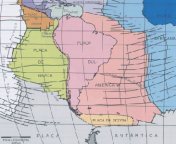Learn More - Geology

Basic Geology
To provide basic geological information which is essential for the knowledge management and rational exploitation of Brazil’s mineral resources.
Geology and the related activities carried out by CPRM, are performed within the context of the Geology of Brazil Program, which basically comprises geological surveying, as well as scientific and technical research and studies in the following fields of knowledge: Geology, Geophysics, Geochemistry, Geochronology, Marine Geology, Paleontology and Remote Sensing.
Further information:
- The Geological Map of Brazil - Scale 1:1.000.000
- "Geology, Tectonic and Mineral Resources from Brazil" - Book and DVD
Marine Geology
CPRM - geological Survey of Brazil is an integrated part of the Ministry of Mines and Energy, directly linked to the State Secretariat of Geology, Mining and Mineral Processing.
Through its Division of Marine Geology (DIGEOM), CPRM provides human, technical and operational resources to meet the demands of the Brazilian society concerning the geological knowledge and the evaluation of the mineral potential of the Brazilian Legal Continental Shelf and adjacent oceanic areas in South Atlantic Ocean. DIGEOM activities are carried out in partnership with Brazilian Navy and Brazilian universities.
In this context, the mission of CPRM is to provide geological information for decision-making by government agencies and Brazilian mining companies involved with the development of marine mineral resources and environmental management of the Brazilian Legal Continental Shelf and Adjacent international seabed area.
CPRM also exercise the technical an operational coordination of the following national programs, carried out in the framework of the Inteministry Commission for the Resources of the Sea (CIRM):
- Programme for the Assessment of Marine Mineral Resources of the Legal Brazilian Continental Shelf - REMPLAC, under the general coordination of the ministry of Mines and Energy.
Was designed with the aim to research and increase knowledge of the seabed and sub-soil, as well as to collect the necessary information to allow integrated management of the Brazilian Continental Shelf. This programme was developed with the participation of various segments of government agencies, research institutions and public enterprises. Marine scientific research and other activities from REMPLAC are carried out individually by or in partnership between the Geological Survey of Brazil, national research institutions from several Brazilian universities and the Directorate of Hydrography and Navigation from the Brazilian Navy.
- Programme for prospecting and Exploration of Mineral Resources of the International Seabed Area in the South and Equatorial Atlantic Ocean (PROAREA), under the general coodirnation of the ministry of External Relations (MRE).
Geodynamics
Modern geochronology techniques have become indispensable resources for basic geological cartography, having been used systematically for some decades by geological surveys across the globe.
Over the past decade, the Geological Survey of Brazil started using the conventional TIMS U-Pb geochronological technique and SHRIMP, as well as the Pb-Pb by evaporation and Sm-Nd techniques in its geological cartography studies.
Remote Sensing and Geophysics
Remote Sensing
- Interpretation of air photos, radar images and satellite images for geological mapping.
- Application of digital image processing techniques for land use, environmental and geological research projects.
Geophysics
Basically, this area involves the airborne geophysical surveying of Brazilian territory. As it is a tool that supplements other geology work and is used to help mineral exploration, it focuses on lesser known and poorer areas, such as the north, north-east and center-west regions. In view of its specialized nature, the data acquisition itself is carried out by private firms contracted through public tender.
Airborne geophysics survey, magnetic and gammaspectrometry data processing, data organization and storage in databases; airborne geophysics maps generation; geophysical maps interpretation and integration with geology; mineral and groundwater thematic data; dissemination of geophysical data for the scientific community; ground geophysics surveys using different methods; ground geophysics as support for land use environment and groundwater projects.
Stratigraphy, Paleontology and Sedimentology
- Planning and execution of paleontology studies and research on a micro and macro scale, as well as in palynology, organic palynology and integrated stratigraphic studies.
- Correlation of paleontology and paleoecological data to use fossils as paleoenvironmental indicators.
- Integration with other disciplines to obtain theme-based and geological maps of sedimentary basins.
- Research of organic components which form mineral deposits.
